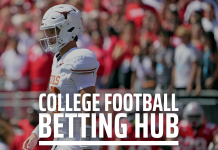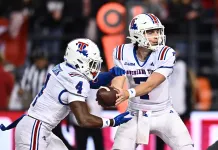Projecting College Football Improvement/Decline:
I hope you enjoyed my piece earlier in the week regarding College Football Personnel Transitional Systems on VSiN.com. It was a lead into this article, as I move from PERSONNEL characteristics to STATISTICAL characteristics in determining which teams fit the bill of being ready to improve or decline in 2024. I like to separate the pieces. First, it’s a lot to digest. Second, it’s two different focuses, the last article being on college football coaching and player personnel, and this one being on some of the statistical traits from teams the prior season that make them prime candidates for improving or worsening in the upcoming fall.
Recalling some of my thoughts last week about the foundation of this article series. One of the most difficult things about handicapping college sports is evaluating teams from one season to the next. Many factors can affect a team’s strength and/or how much different they might wind up being from the previous season. You must consider personnel losses, coaching changes, lost or gained momentum, and many other factors. Sometimes, the changes can be immense. Adding to the difficulty is the thought that many programs are taking players right out of their most recent recruiting or transfer class and plugging them in starting spots early. The massive growth of the portal and assessing its immediate impact has only increased the challenge.
Over the last few years, we have witnessed situations never seen before in college football. The 2020 season was of course, the COVID season, and that brought little to no fans in the stands, players and teams opting out, and major modifications to every team’s schedule. In 2021-22, we saw the impact of “super seniors,” and the most returning experience to the field we’ve ever encountered. For 2023, the experience factor took a huge hit, as those super seniors were gone for the most part, leaving behind veteran but inexperienced players who otherwise would have benefited from starting roles prior. That had sort of a return to normalcy effect on college football. Other than the transfer portal expansion and perhaps the playoff expansion, we are as close to pre-COVID era norms as we’ve been. We’ll see how it plays out in the upcoming season.
What I have sought to do in recent years in addressing the difficulty of massive year-to-year change in college football was to try to quantify the signs of potential improvement or decline out of teams when considering some year-to-year transitional situations. As I indicated earlier last week, I looked at personnel factors, many of which make up my College Football Stability scores. This week, I dive into statistics from the prior season that can best forecast a team’s upcoming prospects.
Are there revealing statistics from last season that can predict the coming college football season?
Sometimes, teams just catch consistently good or bad breaks throughout a given season that significantly impact their record and spread success. Let’s dig through the data to see if we can find anything that might help us find some strong fade or follow teams for 2024.
- There have been 71 teams over the last 11 seasons that have endured losing seasons despite outscoring their opponents. Of those, 31 brought back 13 or more starters, including their quarterback. The collective improvement of this group of teams was about 15.7% SU. These teams combined to go 52.7% ATS, a profit-making collection.
Potential improve teams for 2024: AUBURN, FLORIDA, LA LAFAYETTE, TCU - Alternatively, there have been 67 teams over the last 11 seasons that have enjoyed winning seasons despite being outscored by their opponents. Of those, 13 brought back 13 or fewer starters and turned to a new starting quarterback. Only one team improved (by one win), and the collective decline of this group of teams was a drop off of about 18.9% SU and 5.9% ATS. The combined record of the 13 teams was 44.8% ATS.
Potential decline teams for 2024: GEORGIA STATE
Naturally, turnover luck is an easy to recognize opportunity for spotting teams capable of improving or in danger of falling from season to season. For the last 11 seasons, teams that had a turnover ratio of -1.0 or worse per game improved by 13.8% winning percentage the next season. Those that were in the -0.1 to -0.9 range improved by 4.1%. On the opposite side of the coin, teams with a turnover ratio of +1.0 or better dropped by 13.6%, while those in the +0.1 to +0.9 range were about 3.5% worse the next year. Of course, with this much straight forward data, we must dig further into this.
- Over the last nine seasons, there have been 18 teams that managed to go .500 or better against the spread despite having a -1.0 or worse turnover differential per game. Of those teams, only three regressed in the follow-up campaign, and the average improvement for the entire group was 12.8% SU while winning 2.0 more games on average.
Potential improve team for 2024: RICE (for a second straight season!) - In the “there’s nowhere to go but up category,” since 2013, there have been 49 teams that have won two or fewer games in a season while enduring a -1.0 or worse turnover ratio. Only three of those 49 teams got worse, while 41 improved. The average win improvement for the 41 teams was 3.0 per season. The SU win % upgrade was 23.9%, and the ATS improvement was 18.7%. Despite the mistake-prone play, the most dramatic improvement came from those teams brought back 15 or more starters. That group of 23 teams improved by 4.5 wins per season, 26.8% SU winning percentage, and 25% ATS!
Potential improve teams for 2024: NONE unfortunately, as Temple was closest with three wins in 2023 - There is a potential landmine system that has affected teams coming off a season in which they enjoyed a positive 1.0 or better turnover differential but are now starting fresh at quarterback. The 33 most recent teams that have fit this bill have dropped by 2.7 wins per season in the next campaign, representing a 19.9% plunge outright and a 12.3% dip ATS. This angle affected LA Lafayette and Nevada in 2022, and both teams dropped by at least six wins each! Last year, Illinois fell by three wins.
Potential decline teams for 2024: NORTHWESTERN, MICHIGAN - It can easily be argued that the teams that got the “luckiest” in the prior season were those that had the best turnover differentials combined with smallest point differentials. It can also be predicted that these teams are due for a fall when “starting over.” Historically, that is the case, as only seven of the last 35 teams to have a TO differential of +1.0 or better and a PPG differential of +12.0 or less went on to improve their winning percentage the next season. The rest declined by 3.0 wins per season, for an average percentage drop of 23.1% outright and 13.7% ATS. Collectively, they were 43.3% ATS.
Potential decline teams for 2024: NORTHWESTERN
Analyzing the quality of wins and losses from the prior season
You will find a lot of prognosticators that tout close wins or losses as motivation for a team heading into the next season. I am going to take a look at that as well as blowout wins and losses. I define close wins/losses as 7 or fewer points, and blowout wins/losses as 20 or more points.
- Experienced teams have shown a penchant for bouncing back. Coming off seasons in which they lost at least six games by 20 points or more, teams with at least 13 starters back since ‘13 have wiped the slate clean enough to improve by 1.9 wins per season. This represents a 15.1% improvement outright and a jump of 19.8% ATS. There have been 62 of these such teams over the last decade-plus and only eight got worse.
Potential improve teams for 2024: KENT STATE - There have been 92 teams over the last 11 seasons that have lost one or fewer games by 20 points or more in a given season but still finished with a losing record. Of the 62 that brought back 13 or more starters the next season, only 11 finished worse the next season. The average win improvement of this group was 2.5 per season, good for a 16.9% jump outright and a 5.9% bump against the spread.
Potential improve teams for 2024: FLORIDA, ILLINOIS, KENNESAW STATE, LA LAFAYETTE, PITTSBURGH, UCF - There have been 63 teams over the last 11 seasons that started a new quarterback after a season in which they finished with a winning record despite suffering three or more losses of 20 points or more. Only six of those 63 teams finished with a better record the next season, with the average drop being 14.3% or 2.4 wins per season.
Potential decline teams for 2024: GEORGIA STATE, RUTGERS, SAN JOSE STATE, WYOMING - As another sign of experienced teams being able to wipe the slate clean, only 10 of the last 72 qualifiers that failed to record a blowout win of 20 points or more and are bringing back 16+ starters got worse the next season. The average win gain was a whopping 2.6, good for a 15.7% SU bump combined with an 11.7% ATS climb. This group also recorded a profit-making 52.9% ATS mark.
Potential improve teams for 2024: BOSTON COLLEGE, STANFORD, VIRGINIA - There have been 14 teams that have recorded 7+ blowout wins of 20 points or more one season, then had to change coaches for one reason or another. Only ONE of the 14 teams got better the next season, and collectively, they dropped by an average of 19%, or 2.7 wins per season.
Potential decline team for 2024: MICHIGAN - Close losses can be a galvanizing factor for teams that stay the course. In fact, of the 32 teams over the last 11 seasons that suffered 5+ close losses of seven points or less and brought back their head coach and at least half of their starters (11+), only two finished worse the next season. The average win improvement was 2.6 per season, representing a 19.3% jump.
Potential improve teams for 2024: ARKANSAS, COLORADO, KENNESAW STATE, LA LAFAYETTE, NEBRASKA, SAM HOUSTON STATE, VIRGINIA - Not being tested by close losses can be a warning signal for inexperienced teams on the verge of dropping. There have been 37 teams over the last 11 seasons that won 9, 10, or 11 games while suffering 0 or 1 close losses of seven points or less and brought back only half of their starters (11) or fewer. Of these, only five teams won more games the next season, with the average win drop being 2.9 per season, a 20.1% SU slide accompanied by a 9.8% ATS drop.
Potential decline teams for 2024: AIR FORCE, GEORGIA STATE, JACKSONVILLE STATE, SOUTH ALABAMA, SAN JOSE STATE, TENNESSEE - Close wins are often characterized as getting “lucky” over the course of a season. Well, teams that have a lot of them and then come back inexperienced are naturally expected to drop. Over the last 11 seasons, 57 teams brought back 16 starters or less from a team that was fortunate to get five or more close wins of seven points or fewer in the prior season. Only eight of these teams finished better the next season, with the average win drop being 2.5 per season, a 15.1% plunge.
Potential decline team for 2024: CENTRAL MICHIGAN, FRESNO STATE, ILLINOIS, LOUISVILLE, NORTHWESTERN, OLD DOMINION, TOLEDO, WASHINGTON - Subpar teams that experience zero close wins in a season also tend to improve, particularly when choosing to stay the course. In fact, since 2013, there have been 38 teams that finished under .500 and had ZERO close wins of seven points or fewer in the prior season, then brought back their starting QB, at least 11 total starters, and their full coaching staff (HC, OC, DC). Of those, only four finished worse the next season. The average win bump was 2.6 per season, a 20.3% SU and 8.6% ATS surge.
Potential improve teams for 2024: KENT STATE, NEBRASKA






